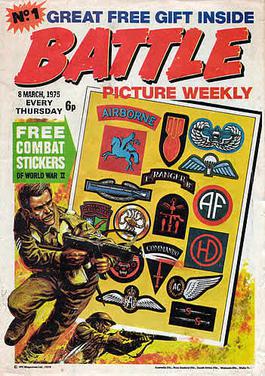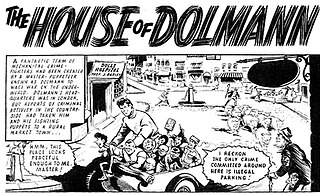
Patrick Eamon Mills is an English comics writer and editor who, along with John Wagner, revitalised British boys comics in the 1970s, and has remained a leading light in British comics ever since. He has been called "the godfather of British comics".

2000 AD is a weekly British science fiction-oriented comic magazine. As a comics anthology it serialises stories in each issue and was first published by IPC Magazines in 1977, the first issue dated 26 February. Since 2000 it has been published by Rebellion Developments.

John Wagner is an American-born British comics writer. Alongside Pat Mills, he helped revitalise British comics in the 1970s, and continues to be active in the British comics industry, occasionally also working in American comics. He is the co-creator, with artist Carlos Ezquerra, of the character Judge Dredd.

Battle Picture Weekly was a British weekly boys' war comic published by IPC Magazines from 8 March 1975 to 23 January 1988, when it merged with the new incarnation of Eagle after 644 issues. Most stories were set in World War II, with some based on other conflicts, while factual features also focused on warfare.

Action was a British weekly boys' comic published by IPC Magazines from 14 February 1976 to 5 November 1977, when it merged with war comic Battle after 86 issues. The comic was created by Pat Mills and Geoff Kemp.

Starlord was a British weekly boys' science fiction comic published by IPC Magazines from 13 May to 7 October 1978, when it merged with 2000 AD after 22 issues. The comic was created by Kelvin Gosnell, and was originally intended as a fortnightly sister title for 2000 AD with higher production values and an older audience, but late changes in production saw it converted into a weekly.

Tornado was a British weekly boys' adventure comic published by IPC Magazines from 24 March to 18 August 1979. The comic was partly created as a way to use up stories already commissioned for the other titles, and was marred by a difficult production. Tornado sold poorly and was merged with 2000 AD after 22 issues.
Massimo Belardinelli was an Italian comic artist best known for his work in the British science fiction comic 2000 AD.

Tom Tully was a noted British comic writer, mostly of sports and action-adventure stories. He was the longest-running writer of the popular football-themed strip Roy of the Rovers, which he wrote for much of Roy Race's playing career until the weekly comic closed in 1993. Other notable strips penned by Tully included The Steel Claw, The House of Dolmann, The Incredible Adventures of Janus Stark, The Leopard from Lime Street, The Robo Machines, and Harlem Heroes. During his three-decade career, Tully wrote exclusively for what became known as the IPC line of publishers: Amalgamated Press/Odhams/Longacre Press/Fleetway/IPC Magazines.
Harlem Heroes is a British comic strip that formed part of the original line-up of stories in 2000 AD. Inspired by the popularity during the 1970s of kung fu films and the Harlem Globetrotters, Harlem Heroes was devised by Pat Mills, employing elements from his Hellball comic strip, and scripted by Tom Tully. Initially, the series was to have been drawn by Carlos Trigo but the Spanish artist was replaced by Dave Gibbons prior to the first issue's publication. From issue 25 Massimo Belardinelli drew the concluding episodes of the first series and would be retained as its regular artist for the strip's reinvention as Inferno.

"The House of Dolmann" is a British comic strip published by Fleetway Publications and later IPC Magazines in the boys' comic anthology title Valiant between 29 October 1966 to 11 April 1970, with a brief revival from 7 September to 26 October 1974. Written by Tom Tully and primarily illustrated by Eric Bradbury, the strip centred on the exploits of genius inventor Eric Dolmann and his army of crime-fighting robot 'puppets'.

"Hook Jaw" is a British comic adventure story published in the weekly anthology Action from 14 February to 12 November 1977 by IPC Magazines.

Wildcat was a fortnightly British comics periodical published by Fleetway Publications from 22 October 1988 to 25 March 1989. A science fiction adventure comic, the title only lasted for 12 editions before being merged with another Fleetway title, Eagle.

"Hellman of Hammer Force" is a British comic strip published by IPC Magazines in the boys' comic anthology titles Action and later Battle between 14 February 1976 and 8 July 1978. The story was set in World War II; while war comics were common material in British comics of the time, "Hellman of Hammer Force" was rare for its use of a sympathetic Wehrmacht officer as the lead protagonist. While not as controversial as fellow Action stories such as "Kids Rule O.K." and "Hookjaw" it was nevertheless caught up in the campaign against the title by the British tabloid press.

"Johnny Red" is a British comic war story published in the weekly anthology Battle Picture Weekly from 29 January 1977 to 17 January 1987 by IPC Magazines. Set during World War II, the story follows Johnny 'Red' Redburn, a British pilot leading the Falcon Squadron unit of the Soviet Air Forces on the Eastern Front. Written by Tom Tully and initially drawn by Joe Colquhoun, the strip was the longest-running in Battle's history, only ending in 1987 when financial constraints saw it switched to reprints.

"Rat Pack" is a British comic war story published in the weekly anthology Battle Picture Weekly from 8 March 1975 to 8 July 1978 by IPC Magazines. Set during World War II, the story follows the eponymous unit, compromised of a penal military unit of four criminals recruited by British Army officer Major Taggart to undertake deadly missions.

"Dredger" is a British comic action story published in the weekly anthologies Action and Battle Action from 14 February 1976 to 7 October 1978 by IPC Magazines. The strip focused on the eponymous, uncompromising secret agent and his partner Breed, featuring self-contained stories that featured Dredger getting out of lethal situations with an innovative and violent approach.

"Look Out for Lefty!" is a British comic sports story published in the weekly anthology Action from 1 May 1976 to 12 November 1977 by IPC Magazines. The strip focused aspiring footballer Kenny Lampton, nicknamed 'Lefty' due to his powerful left foot shot.

Eagle, sometimes referred to as The New Eagle and known at various points in its life as Eagle and Scream!, Eagle and Tiger, Eagle and Battle, Eagle and M.A.S.K. and Eagle and Wildcat, was a British boys' adventure comic published by IPC Magazines from 27 March 1982 to January 1994. A revival of the famous Eagle, the title was initially a weekly publication until turning into a monthly in May 1991. The title was finally cancelled in January 1994, after 505 issues.

















